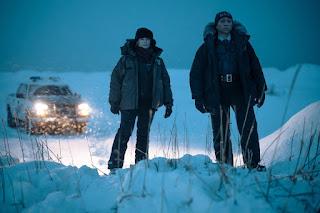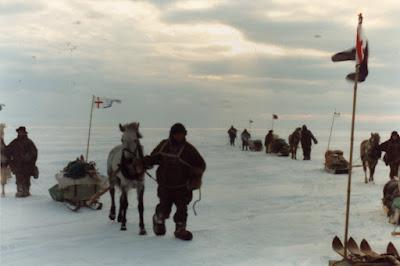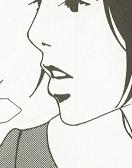
I wouldn’t say that The Last Winter is a particularly great film. I watched it based on a list of recommendations for if you’re enjoying the new season of True Detective, which I am, and it sounded interesting based on the story it tells. There is also an inescapable draw to seeing Connie Britton reunited with Zach Gilford, like an emotional reminder of so many seasons of Friday Night Lights. The Last Winter is a horror film, definitely profoundly influenced by the ultimate polar horror film, The Thing. It is set in an Alaskan outpost for an oil-drilling company that is trying to develop the area for extraction, a project driven by Ron Perlman, who plays Ed Pollack straightforwardly the way you’d expect someone obsessed with wringing oil from the ground would be. At one point, he argues that there is a god-given right to such riches. This is a man who takes humanity’s domination of nature very seriously. His ideology is directly opposed to James Hoffman (James Le Gros, who will forever interest me just for the stark contrast of appearing both in early 2000 Ally McBeal and Kelly Reichardt’s films). Hoffman is a scientist studying the impacts of climate change on the polar regions, but he is also bought by the oil company he works for, which severely restricts how he can act on the concerning data he finds in Alaska. The temperature is rising. The permafrost is melting. The wind feels hostile, as if imbued with intent. Halfway through the story, it begins raining – in February, during the Arctic winter. I doubt that much of the film will stay with me, long-term, but a conversation with the station’s chef Dawn (played beautifully by Joanne Shenandoah) will: She explains a word that her native people have for friends who are acting out of character, appear disconcertingly changed (uggianaqtuq), and says that this could be applied to the weather that they are all experiencing out there (a reference possibly taken right from the Smithsonian Environmental Research Center). As the horror unfolds, the two possible meanings of the word come to fruition. As each of the characters encounters the strangeness, the change, the reality of the impact of climate change, they begin to irrevocably change and lose their minds. Zach Gilford’s Maxwell is the first victim, as if his hesitancy about his role at the station and uncertainty about his own purpose makes him more susceptible to the forces at play. The station workers begin turning against each other, and when they venture out of their isolation, they discover that whatever is impacting them is not contained to their station alone. There is a real, scientific concern here about what it would mean for the climate if the permafrost disappeared and released all the carbon is has stored (this scientific paper released in 2022 cites that the Arctic permafrost stores nearly 1,700 billion metric tons of frozen carbon, and this carbon sink is now in danger of turning into a carbon source). The more horror-story prone aspect is the idea that the melting permafrost will reveal other things frozen in the ice that will come to haunt humanity, such as ancient viruses or long-forgotten creatures that could come back to life (an idea that has felt like a mainstay in horror novels about the polar regions for a while). The Last Winter doesn’t really limit itself to any of these ideas – it could be a virus that is affecting the mental health of the station workers – but eventually, towards the end, the survivors do see a monster of some kind that inevitably recalls Dan Simmons’ Tuunbaq, even though The Terror wasn’t released until 2007. It is unclear if this creature is corporeal or not, if it, like the Tuunbaq, exists to restore balance where white men have upset it. It could just as well be an expression of guilty minds shaping the knowledge of the destruction they have wrought into something concrete. I liked the eloquent ending, in which sole survivor Connie Britton awakes in a hospital to a scene of destruction that remains hauntingly off-screen, but is very much felt in the soundscape, in the sludge beneath her boots, which make it clear how literal the title of the film ultimately is.
There are a lot of obvious connection points to the new season of True Detective here, which hasn’t finished yet but appears to embrace the idea of the supernatural a lot more than the much debated first season ultimately did. This is perhaps a feature that feels more earned considering that the Issa López developed season allows some room for the beliefs of the local Inuit to clash against Jodie Foster’s Elizabeth Danvers supposed rationality and cynicism (and, especially in how she handles her stepdaughter’s attempts to connect to culture, racism). True Detective is set in an Alaskan mining town, in which the resource extraction has led to horrible impacts on the local community. The water seems to be poisoned. There is a slew of traumatic stillborn babies, and horrifying violence against Indigenous women that is mostly met with indifference by the local police force. Danvers reminds characters who point out these dangers that the mine is what keeps the town alive, a claim severely undermined by the many attempts by local indigenous activists to reclaim what has been stolen from them, and the sheer fact of their existence on this land for thousands of years. They were here before – and possibly, as has been whatever specter is haunting the town now. The mystery kicks off when the scientists in a research station (True Detective is very conscious of what came before in terms of polar horror!) disappear into the ice, and are later found frozen together in what Danvers terms a “corpsecicle” – a spine-chillingly gruesome installation of ice and meat that Danvers drags to the local ice rink to defrost. Aspects of this connect to an old, unsolved crime in which an Indigenous activist and midwife was killed and then, inevitably, let down by the ensuing incomplete investigation. Some of the success of this season is that there are so many open venues for explanation, and it feels completely in the air which one the show ultimately will go down. There’s a hinted story here about how the effects of the mine have destroyed nature irreparably, have destroyed a pre-existing community and also created a schism between those economically dependent on it and those who are defending their ancestral home. There are the scientists themselves, who were taking samples from the ice to find compounds for medicine and research into arresting aging, or averting death – who may have found something ancient and incomprehensible instead. The much-discussed ending of the first season of True Detective ultimately went with an almost pedestrian explanation after hinting at something much greater. This new season cites some of those mysteries, and might still either deliver or deliberately refuse to.

All of this feels like a great context for watching the 1985 miniseries The Last Place on Earth, based on the non-fiction book by Roland Huntford about the race between Amundsen and Scott for the South Pole, for the first time. It’s an interesting series to consider just based on format alone – miniseries based on novels have been so popular lately (think the recent Liane Morarity adaptations, or Sharp Objects, Pachinko and Little Fires Everywhere). In my head, this has felt like a new phenomenon that goes hand-in-hand with the changes that streaming has affected in the television landscape, mainly because for the majority of my television experience, the idea of six to ten more than hour-long episodes of television making up a season would have felt odd, but now feels less so with the model of shorter seasons with episodes of varying length, frequently released in one go rather than week-by-week. In fact, there are a lot of other examples from the 70s and 80s – the adaptation of Alex Haley’s Roots in 1977, the original 1990s House of Cards, BBC adaptations Jane Austen’s novels. Regardless, something about the scope of The Last Place of Earth is deeply surprising to me. It dedicates a lot of time just to the build-up of the two competing expeditions, developing Amundsen and Scott as diametrically opposed characters, as if their societal context – which affects their ultimate approach to how they lead their respective pushes for the Pole – was just as important to show as the expeditions themselves. The first episode shows Scott’s failure in the Navy, desperation to prove himself, struggle with his personal relationships, as much as it follows Amundsen’s disappointment when the North Pole, his obsession, is claimed by his good friend Frederick Cook (the question of whether Cook, or Peary, ever reached the North Pole would warrant another miniseries), and his ultimate daring decision to race Scott for the South Pole, secretly diverting his government-funded expedition on Nansen’s famed Fram to the other side of the world. It shows in harrowing detail how both expedition’s attempts to find funding strains relationships (Amundsen’s long-suffering brother and “business manager” gets more airtime than members of the actual expedition). This show has time to be detailed and precise, which is joyful, and it will all come together to make Huntford’s ultimate historical argument that Scott failed because of his refusal to adapt the Inuit-tested strategies that Amundsen embraced. There is much rah-rahing about the British empire here, about how the white spaces on the maps must eventually be part of Empire, that will inevitably end in the frozen tent 12.5 miles from the next depot. The goal here isn’t resource extraction, yet – but there is still an ultimate connection in terms of the ideology that makes these “great men” believe that they could ever dominate a land so hostile to humans.
The Last Place on Earth is of course not a horror story in the traditional sense – there is nothing here that is released from the ice to haunt the explorers, there are no monsters or viruses here to feed off white men who do not comprehend that they have perhaps tread where nobody should go. The horror lies in the physical exhaustion, the slow death of starvation, the impact of frostbite and unpredictable weather. As great as many of the recent horror novels about the polar regions are – especially Ally Wilkes’, and the television adaptation of The Terror – nothing comes close to the sheer desperation of Apsley Cherry-Garrard (played here by a young Hugh Grant at the beginning of his career) writing about his lost friends, calculating the necessary caloric intake for future expeditions to avoid the fate Scott, or sitting in the halls of the Natural History Museum to view the penguin eggs that he and his two doomed companions collected during their harrowing winter journey, only to find the museum workers disinterested in their great feat that has cost them so much. The horrible irony of The Last Place on Earth is that Amundsen, with his reliance on dogs, skies and Inuit methods of survival, had a comparably easy time to reach his goal (discounting some frostbitten feet, a kind of body horror in and of itself), while Scott struggled severely with his ponies, his failed motor vehicles and the over-extension of matching the scientific research with the ultimate goal of the Pole. It’s a miscalculation that results in the death of his South Pole party, hubris met with inevitable punishment in an environment that does not permit miscalculation on such an epic scale.
The Last Winter (2006), directed by Larry Fessenden, starring Ron Perlman, James Le Gros, Connie Britton, Zach Gilford, Kevin Corrigan, Jamie Harrold, Pato Hoffmann, Joanne Shenandoah.
True Detective: Night Country (2024), created by Issa López, starring Jodie Foster, Kali Reis, Fiona Shaw, Finn Bennett, Isabella LaBlanc, John Hawkes, L'Xeis Diane Benson, Aka Niviâna, Angunnguaq Larsen.
The Last Place on Earth (1985), created by Trevor Griffiths, based on a book by Roland Huntford, starring Martin Shaw, Sverre Anker Ousdal, Stephen Moore, Hugh Grant, Michael Maloney, Richard Morant, Sylvester McCoy.

